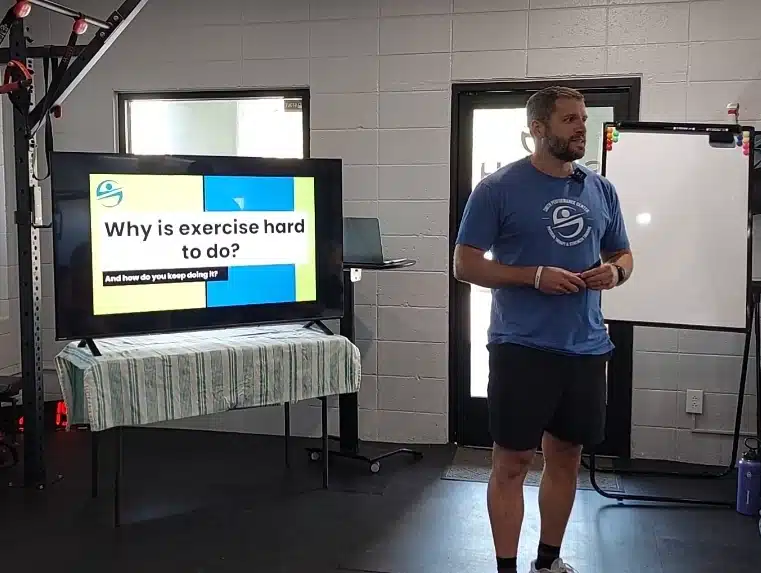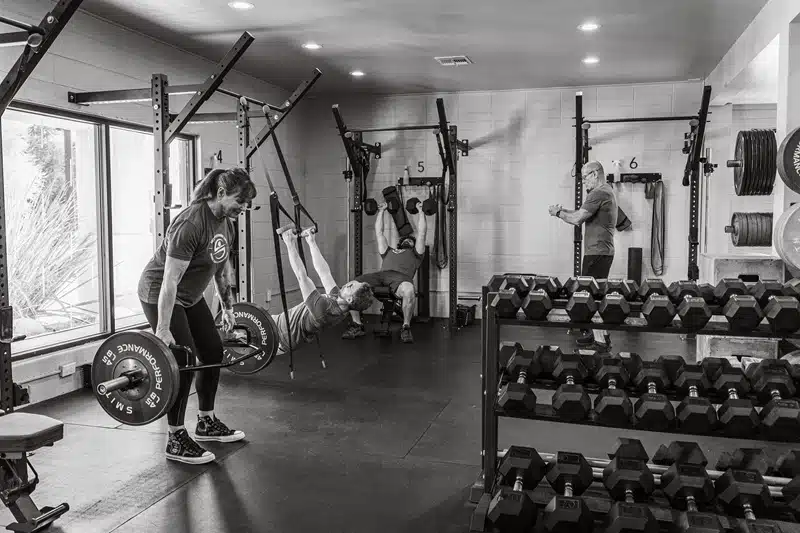
“The real challenge isn’t knowing exercise is important—it’s showing up and doing the work. Build the habit, overcome the barriers, and take action today.”
Starting an exercise program usually begins with a detailed look at your goals and a plan to achieve them.
Showing up consistently is assumed.
After decades in the health and wellness industry as a personal trainer, strength coach, exercise physiologist, and physical therapist, I’ve seen firsthand that the problem isn’t your goals, program structure, or knowledge of the importance of exercise. You already know regular exercise is crucial. Nor is the problem finding a place to work out, scheduling gym time, or getting the right equipment for home.
The real issue is execution: showing up and doing the work.
Exercise is hard to start. Exercise is hard to maintain.
Why?
There are four major reasons:
- Evolutionary Mismatch: We did not evolve to exercise; we evolved to conserve calories.
- Injury and Pain: Exercise-related injuries and pain are common and impossible to prevent entirely.
- Shifting Barriers: Exercise barriers change throughout your life; one solution does not work forever.
- Knowledge vs. Action: Knowing the importance of exercise isn’t enough to drive action—it can even make you feel bad about yourself.
Evolutionary Mismatch
We did not evolve to exercise; we evolved to conserve calories.
Our ancestors developed in an environment with limited access to calories.
The body’s ability to conserve energy allowed humans to survive periods of extreme hardship. We moved to gain sufficient food and then spent as much time as possible resting1. Conserving energy is a built-in feature of the body, as seen in our highly adapted physiology that saves body fat, reduces energy for walking, and drives an innate impulse to rest when movement is not necessary.
We often hear we need to get back to our heritage and return to what we used to do. This misses the reality of modern society. We are doing what our ancestors would have done; moved when we have to and not one bit more 1. The physical activity of hunting and gathering humans was forced. If you read accounts from modern anthropologists visiting the few remaining tribes of hunters and gatherers, voluntary exercise is seen as ridiculous 2.
The mismatch between our genetic roots is a significant reason why less than 26% of men and 19% of women meet the recommended exercise minimums 3.
This is why lack of exercise combined with the overabundance of processed, calorie-dense foods, we see skyrocketing rates of obesity or so called diseases of civilization.
We did not evolve to exercise; we evolved to handle forced physical activity and conserve calories.
You cannot rely on your ‘ancestral heritage’ when trying to develop an exercise habit.
Injury and Pain
Injury and pain related to exercise are common and impossible to fully prevent4.
The natural response to this is to try to find a form of exercise that will not cause an injury, but increased activity naturally leads to more injuries regardless of the activity5. And this is not an issue of researchers exaggerating the problem. From our own data having supported thousands of different workout plans, the rate of injury is far higher than those reported in the literature.
Its why we do open clinic – we head off issues before they stop you.
Unfortunately Injury is a leading reason individuals do not start exercising 6 and a significant reason why they stop7. Studies found 20% of respondents were not more active due to an injury. Beyond this, one in five Americans suffer from chronic pain 8, another barrier that stops people from starting to workout.
If you exercise, there is an injury waiting for you in the future.
Shifting Barriers
Exercise barriers change throughout your life; one solution does not work forever.
During a recent talk, I discussed how motivation and ability interact to determine if you take action9. A participant stated that their motivation used to be built on how exercise made them look. They exercised to look fit, but now they could take a drug that did it better. They now struggle to find a compelling reason to exercise because their original reason is gone.
This is an example of a shifting exercise barrier.
The shift can happen with new life circumstances like a new child or job, a change in technology that sucks up your attention, or the natural aging process that makes you afraid of falling. An exercise barrier is anything that prevents or reduces the likelihood of working out. The most common barriers reported are injury, pain, time, location of workout facility, work duties and family responsibilities.
The shift means that the tools of today may not work in the future.
Knowledge vs. Action
Knowledge of the importance of exercise is not sufficient to drive action.
The majority of Americans think exercise is important, but as we noted above the majority do not hit the minimum recommended amount. We know that completely inactive individuals experience large health benefits from even a small increase in activity3. The benefits are massive: lower risk of all-cause mortality, cardiovascular disease mortality of cardiovascular disease, hypertension, type 2 diabetes, and cancers. This does not include the benefits to cognition, reduced risk of dementia, and improved self ratings of quality of life.
This does not move the needle toward activity.
It does make it easier to negatively judge yourself when you fall off the exercise band wagon.
The takeaways
Every human deals with these 4 issues. We need to exercise despite them. We cannot ignore these inherent problems.
In modern society, physical inactivity is easy and getting easier; we must push ourselves to overcome our natural laziness and exercise.
Activity will cause injuries, but we must find ways to stay active despite them.
You need to identify your barriers to exercise and monitor for any shifts.
And finally, taking action is more crucial than simply understanding the importance of exercise. You need to act and act today.
References
1. O’Keefe, J. H., Vogel, R., Lavie, C. J. & Cordain, L. Achieving Hunter-gatherer Fitness in the 21st Century: Back to the Future. Am. J. Med. 123, 1082–1086 (2010).
2. Exercised by Daniel Lieberman: 9780525434788 | PenguinRandomHouse.com: Books. https://www.penguinrandomhouse.com/books/557099/exercised-by-daniel-e-lieberman/.
3. Physical Activity Guidelines for Americans, 2nd edition.
4. Bahr, R. Why screening tests to predict injury do not work—and probably never will…: a critical review. Br J Sports Med 50, 776–780 (2016).
5. Powell, K. E., Heath, G. W., Kresnow, M.-J., Sacks, J. J. & Branche, C. M. Injury rates from walking, gardening, weightlifting, outdoor bicycling, and aerobics. Med. Sci. Sports Exerc. 30, 1246 (1998).
6. Finch, C., Owen, N. & Price, R. Current injury or disability as a barrier to being more physically active. Med. Sci. Sports Exerc. 33, 778–782 (2001).
7. Sallis, JamesF. et al. Lifetime history of relapse from exercise. Addict. Behav. 15, 573–579 (1990).
8. Zelaya, C. E. Chronic Pain and High-impact Chronic Pain Among U.S. Adults, 2019. (2020).
9. Fogg, B. A behavior model for persuasive design. in Proceedings of the 4th International Conference on Persuasive Technology 1–7 (ACM, Claremont California USA, 2009). doi:10.1145/1541948.1541999.
Do you struggle with maintaining an exercise routine?
Life obligations get in the way of being active. We know exercise is important but there are too many things getting in the way.
Let us help you develop an exercise routine that can work even with a busy schedule.



